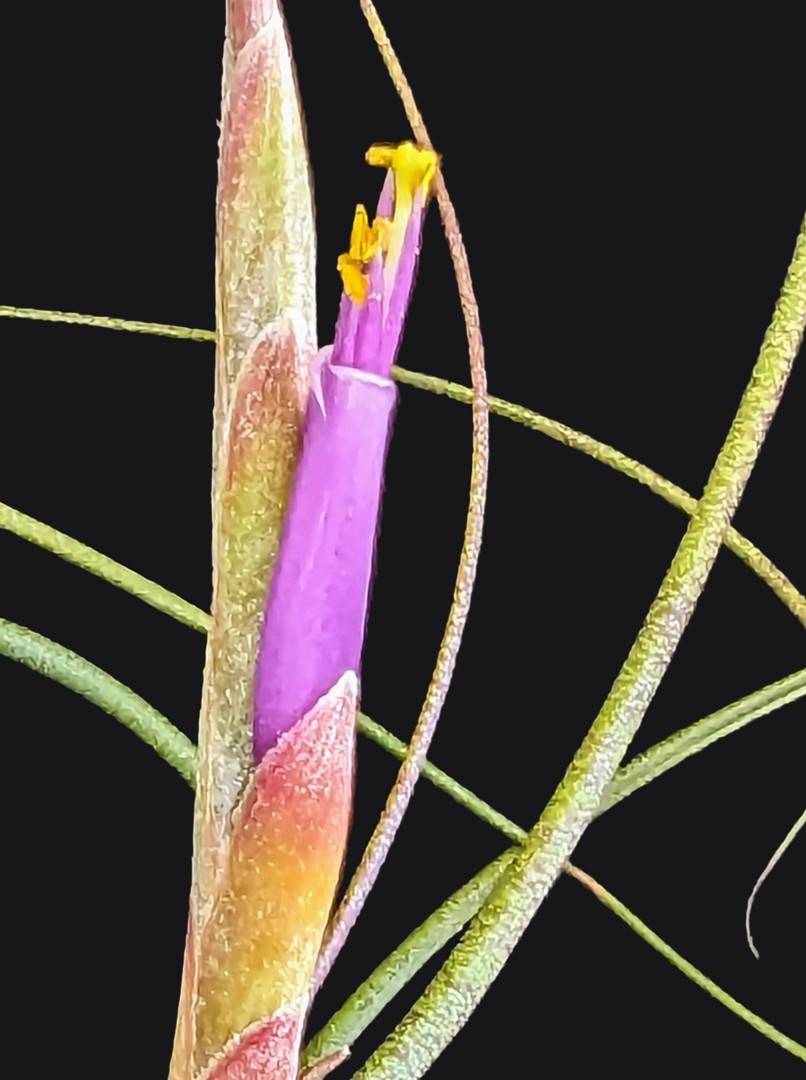
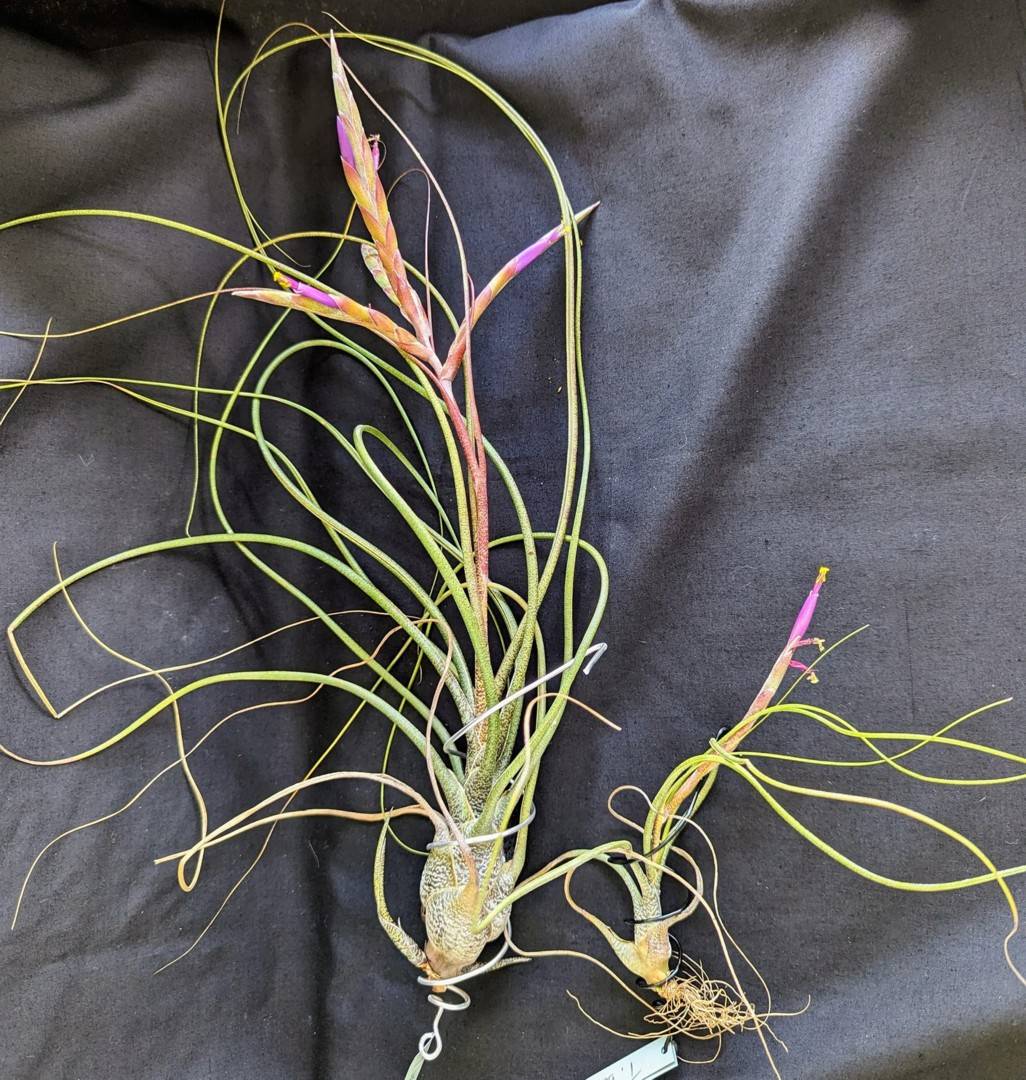
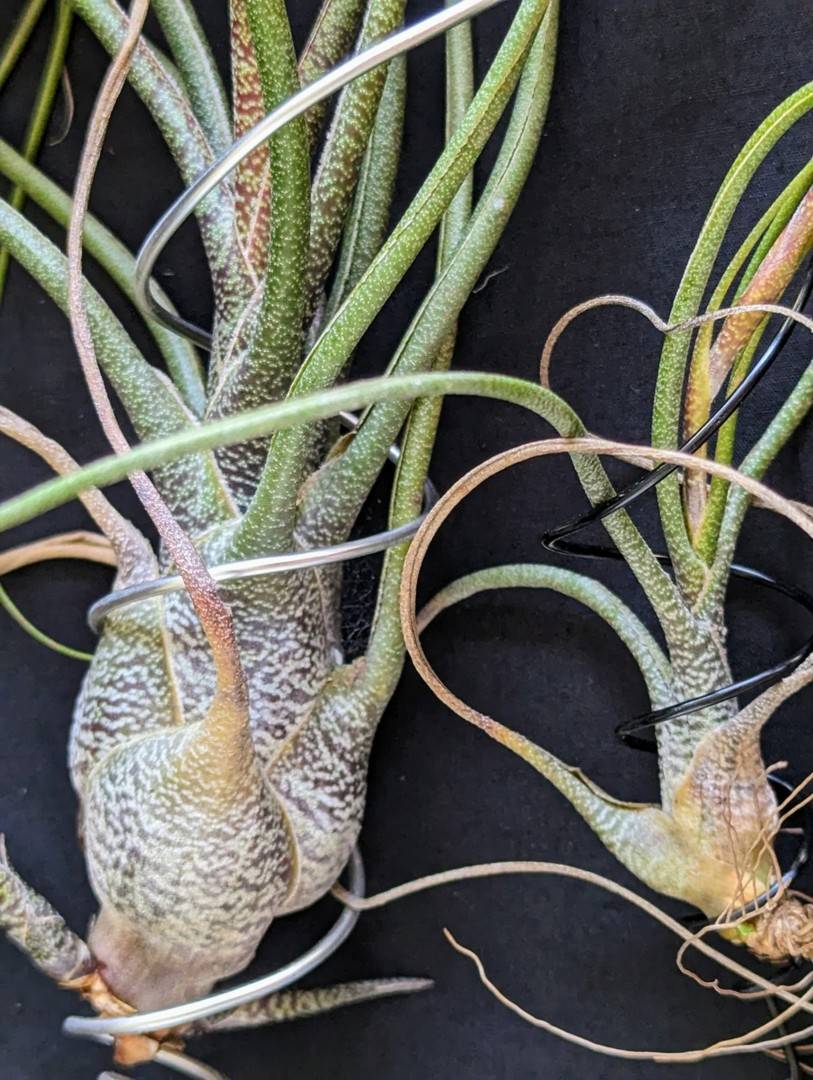
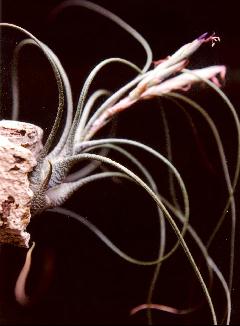
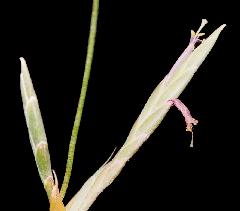
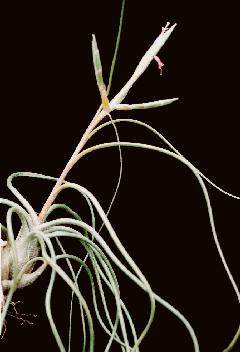
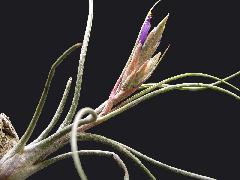
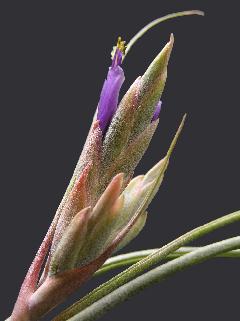

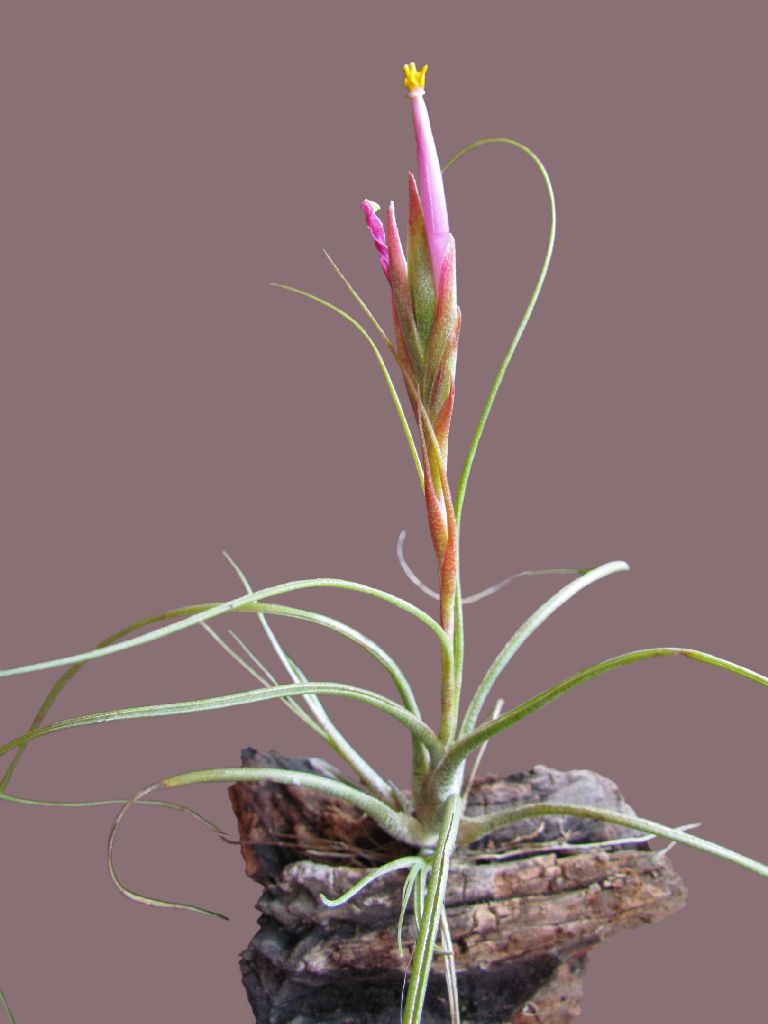
Desc from S&D p990-2
Plant stemless, 2-3 dm high.
Leaves few in a bulbous rosette, to 5 dm long, wholly covered with fine pale appressed scales, the margins at first ciliate with coarse scales;
Sheaths suborbicular, inflated, forming a pseudobulb 2~5 mm in diameter, dark brown or purple with numerous large pale green often confluent spots;
Blades involute-subulate, filiform-attenuate, 3 mm in diameter, contorted.
Scape erect, slender;
Scape-bracts foliaceous, imbricate.
Inflorescence digitate from a few subequal spikes or rarely simple;
Primary bracts subfoliaceous, concolorous, the broadly ovate sheath much shorter than the axillary spike, the linear blade often much exceeding it;
Spikes erect to spreading, linear, acute, strongly complanate, 6-8 cm long, about 1 cm wide at anthesis, 5-8-flowered with 1 or 2 sterile bracts at base.
Floral bracts erect, imbricate, ovate, acute, 20-28 mm long, 10 mm wide, much exceeding the sepals, three to four times as long as the internodes, subcoriaceous, covered with pale appressed scales, prominently nerved and sometimes incurved or slightly carinate toward apex;
Flowers subsessile.
Sepals narrowly elliptic, narrowly obtuse, 12-15 mm long, coriaceous, glabrous, posteriorly connate for 4 mm;
Petals erect, 30-35 mm long, violet;
Stamens and pistil exserted.
Capsule slenderly cylindric, acute, short-beaked, 3 cm long.
Type. Schiede s n (holotype B), Jalapa, Vera Cruz, Mexico.
DISTRIBUTION. Epiphytic in mostly dry open habitats, 1000-2300 m alt, southern Mexico to Panama.
MEXICO. VERA CRUZ: Mirador, 1841-43, Liebmann 16 (C); 10 May 1929, Skwarra s n (GH); Orizaba, ca 1864, Botteri 1001 (GH); Valley of Cordoba, 17 Mar 1865, Bourgeau 2192 (P); Jalapa, Aug 1866, Hahn s n (P); Oct 1888, Mexicana Com. Geogr. s n (F, GH); 1899, Pringle 8189 (BM, F, GH, MO, NY, US); Zacuapan, Mar 1913, Purpus, 6343 (BM, F, GH, MO, NY, US); Banderilla, 1938, Foster 11 (GH). MEXICO: Valley of Mexico, 30 Jun 1901, Rose & Hay 205 (US). OAXACA: Cuyamecalco, Cuicatlan, 17 Apr 1919, Conzatti & Gomez 3491 (US); Ayutla, 15 Mar 1939, Bevan 399 (GH). CHIAPAS: Canjob, 27 Mar 1904, Goldman 801 (US); Mount Pasitar, Dec 1936, Matuda 358 (MICH, MO, US); Mount Ovando, Feb 1939, Matuda 2657 (NY); Gloria, Escuintla, 20 Jan 1948, Matuda 18564 (MEXU, US); Comitan, 25 Dec 1948, Langman 3793 (MEXU, US); 2 May 1952, Moore 6346-A (BH, US); Monte Bello, Jan 1952, Carlson 2372 (MEXU, US); 25 Mar 1960, Hale 20492 (US); 26 Jan 1965, Breedlove & Raven 8388 (DS, US); Zinacantan, 1 Apr 1965, Breedlove 9525 (DS); 8 Mar 1966, Laughlin 399 (US). GUATEMALA. QUICHE: Quiche to San Pedro Jocopilas, 12 Jan 1939, Standley 62463 (F); Nebaj, 1964, Proctor 25454 (IJ, US). HUEHUETENANGO: Malacatancito, 14 Jan 1939, Standley 62638 (F); Huehuetenango, 2 Jan 1941, Standley 82028 (F, GH). ALTA VERAPAZ: Coban, Mar 1908, Tuerckheim II-2187 (US); 1 Sep 1920, Johnson 721 (US); Tactic, 30 Mar 1941, Standley 90467 (F, GH); 10 Apr 1941, 92020 (F); 14 Apr 1941, 92367 (F). BAJA VERAPAZ: Santa Rosa, Apr 1887, Tuerckheim in J. D. Smith 1172 (GH, US); 30 Mar 1939, Standley 69752 (F); 4 Apr 1941, 91261 (F). SAN MARCOS: Tajamulco, 26 Feb 1940, Steyermark 36686 (F). QUEZALTENANGO: Volcan Santa Maria, 6 Jan 1940, Steyermark 33669 (F); 12 Jan 1940, 33937 (F). PROGRESO: Morazan, 26 Feb 1945, Sharp 45271 (TENN). ZACAPA: Volcan de Monos, 10 Jan 1942, Steyermark 42366 (F, GH). CHIQUIMULA: Jocotan, 10 Nov 1939, Steyermark 31654 (F). JALAPA: Volcan Jumay, 1 Dec 1939, Steyermark 32443 (F, GH). SUCHITEPEQUEZ: Volcan Santa Clara, 23 May 1942, Steyermark 46614 (F, GH). SANTA: ROSA: Zamorora, Apr 1893, Heyde & Lux in J. D. Smith 4628 (GH, US). HONDURAS. COMAYAGUA: El Achote, Siguatepeque, 19 Jul 1936, Yuncker, Dawson & Youse 5981 (GH, MO). MORAZAN: Uyuca, Aug 1943, Rodriguez 590 (F); Mount Uyuca, 8 Dec 1946, Williams & Molina 11183 (GH); 22 Feb 1947, Standley & Molina 4340 (F); Zamorano, 4 Ju1 1964, Gilmartin 940 (US). PARAISO: Guinope, Dec 1943, Rodriguez 1850 (F). SALVADOR. AHUACHAPAN: Laguna Verde, 30 Dec 1950, Rohweder 381-383 (HBG); Laguna de Las Ninfas, 28 Jan 1951, Rohweder 385-386 (HBG). SANTA ANA: Hacienda Los Planes, 16 Dec 1950, Rohweder 376-377, 379-380 (HBG); 24 Feb 1951, 387 (HBG); Volcan San Salvador, 29 Mar 1951, Rohweder 388 (HBG). CHALATENANGO: San Ignacio, 25 Nov 1958, Weberling 3211 (Z). SAN VICENTE: Volcan de San Vicente, Mar 1922, Standley 21546 (GH, US). USULUTAN: Laguna de Alegria, 21 Jan 1951,Rohweder 384 (HBG). NICARAGUA. MATAGALPA: San Ramon, 1963, Heller 5717-A (F); Santa Maria de Ostuma,Jan 1963, Williams, Molina & Williams 23385 (EAP, F, US). JINOTEGA: Ocotillo, Santa Lastenia, 17 Jan 1965, Williams et a1 27868 (EAP, F, US). COSTA RICA. ALAJUELA: Alfaro Ruiz, Zarcero, 26Jan 1939,A. Smith NY-1563 (GH); s d, P-211 (F). SAN JOSE: Tarbaca, 1 May 1956, Williams 19454 (EAP, F, US); Mount Escazu, 1962, Haines 630-B (US). CARTAGO: Cartago, Jan 1887, Cooper in J. D. Smith 5955 (GH, US); Apr 1894, J. D. Smith 4965 (GH, US); Dec 1894, Pittier 9104 (US); 19 Apr 1906, Maxon 61 (US); Feb 1924, Standley 33329 (US); 26 Feb 1926, Standley & Valerio 49508 (US); 49515 (US); 19 Feb 1928, Stork 1008 (F, MICH); 11 Feb 1938, Valerio 1723 (F); 1962, Haines 683 (US); Tucurrique, Apr 1899, Tonduz 13061 (US); Aguacaliente, 10 Feb 1922, Greenman 5553 (GH, MO); Dulce Nombre, 27 Feb 1924, Standley 35796 (US); La Estrella, Mar 1924, Standley 39502 (US); Santiago to Picacho Mondongo, 23 Jan 1933, Brenes 16975 (F); Cerro de la Carpintera, 22 Aug 1940, Chrysler 5533 (F); 30 Apr 1956, Williams 19438 (EAP, F, US). PANAMA. CHIRIQUI: El Boquete, Mar 1911, Pittier 3011 (GH, US); Paso Ancho to Monte Lirio, Rio Chiriqui Viejo, 16 Jan 1939, Allen 1592 (MO).
In Baker Handb. Brom. 174. 1889 but not in S&D index
66. T. VARIEGATA Schlecht. in Linnaea xviii. 429, Wittm. in Berlin Gartenzeit. 1885, 198, fig. 44 (M.D.).
Leaves few in a rosette, with large dilated ovate tightly-clasping leaf-bases variegated with green and brown;
blade setaceous, flexuose, a foot long, thinly lepidote.
Peduncle 3-4 in. long;
bract-leaves with long points.
Spikes about 3, crowded, dense, distichous, 1.5-2 in. long, 0.5 in. diam.;
flower-bracts oblong-lanceolate, greenish, an inch long.
Calyx nearly as long as the bract.
Petals lilac, convolute in a long tube.
Hab. Mexico.
Introduced into cultivation in 1880. Very near T. bulbosa.
Tillandsia butzii var. roseiflora R Ehlers Die Bromelie 2/2002 p55-6
A varietate typica habitu plerumque minori, vaginis foliorum anguste ellipticis, non late ellipticis, foliis non densiter imbricatis pseudobulbum formantiis sed laxe dispositis, inflorescentia plerumque minori et unica spica consistentia et petalis atro-roseis non violaceis differt.
Typus: Mexico, Oaxaca, inter Teotitlan de Camino et Huautla, 1500 m s. m., 3/4/1989, leg. K. & R. Ehlers EM890301 (Holotypus: MEXU).
Other collections: Oaxaca, road to Huautla, EM 981506 leg. R. Ehlers. Oaxaca Puerto - Escondito near Sola de Vega 1900 m EM 8292 and EM 932203 24/3/93 leg. K. & R. Ehlers. Oaxaca, Tlaxiaco to Laguna EM 892202 leg. K. & R. Ehlers. Oaxaca, Copala - Juxtlahuaca EM 892303 leg. K. & R. Ehlers 23/4/89. Oaxaca, El Vergel, EM 980408. Guerrero El Durazno 1750 m EM 900505. Chiapas Comitan - San Christobal near Amatenango EM 891105 leg. K. & R. Ehlers 11/4/89. Chiapas Motosindla - Buenos Aires 1750 m EM 891302 leg. K. & R. Ehlers 13/4/89. Guatemala, Paramos, EG 922503, leg. K. & R. Ehlers 16/3/92.
T. butzii Mez var. butzii and T. butzii Mez var. roseiflora var. nov. Ehlers growing together at the same place:
Oaxaca near Huautla EM 890301
Oaxaca near Copala EM 892303
Oaxaca near Amatenango EM 891105
Oaxaca near Sola de Vega EM93220
Guatemala Paramos EG 922503
At all these locations we found the two plants growing together without hybridizing.
The var. roseiflora differs from the type:
Plant smaller,
Leaves smaller,
Sheaths narrowly elliptic not round to broad-elliptic,
not forming a dense pseudobulb but laxly open bulbous,
Inflorescence smaller, often only one spike, if bipinnate spikes more erect, not spreading,
Petals rose-red not violet.
Dear Derek,
I am going to send you slides. I have more than I knew and they are not too bad, though there is none with the standard I would like to have.
I also make a copy of a slide from Huautla where you see the two var. growing on the same tree.
Sincerely
Renate
I wanted to describe the plant since more than 10 years. It is very common, I have at least 10 different habits from Guatemala, Chiapas and Oaxaca and as well herbarium spec. The only reason I did not is: I have many slides of flowering plants, but not one is really good. Also I tried to make a drawing of the plant years ago, but it does not look good enough to publish it.
The plant is also diffrent from the normal T. butzii, it is smaller, less leaves, these narrower and the sheaths not densely forming a bulb.
I also know one habit where the T. butzii var. butzii and the T. butzii var. roseiflora are growing in the same habit: Oaxaca between Puerto Escondito and Oaxaca near Sola de Vega. Both plants grow there without hybrids.
Renate
(1816) Proposal to conserve the name Tillandsia butzii against T. inanis (Bromeliaeeae) in Taxon 57(2): 647-8. 2008
Walter Till
Faculty Center of Botany, Faculty of Life Sciences, University of Vienna, Rennweg 14, 1030 Wien, Austria.
(1816). Tillandsia butzii Mez in Engler, Pflanzenr. IV32 (Heft l00): 636. 10 Oct 1935 {Monocot.: Bromel}, nom. cons. prop.
Typus: Mexico, "in arboribus Jalapa, April {18}29", Schiede (HAL).
(=) Tillandsia inanis Lindl.in Lindley & Paxton, Paxt. Fl. Gard. l: 159. Dec 1850, nom. rej. prop.
Holotypus: "T. inanis m. in Paxton vol. I", "Herb. J. Lindley, Ph.D." (CGE).
Tillandsia butzii (Bromeliaceae) was published by Carl Mez as a new name for T. variegata Schtldl. (in Linnaea 18: 429. 1845 ("1844")), for which the holotype is a Schiede collection from Mexico sent to Schlechtendal at HAL, not a specimen at B as reported by some (e.g., Smith & Downs in Fl. Neotrop. 14(2): 992. 1977). This substitute was necessary as Schlechtendal's name is a later homonym of Tillandsia variegata Vell. (in Fl. Flumin.: 134. 1829 ("1825")). Since 1935 this Mexican and Central American plant with a pseudobulb and subulate leaf blades, very characteristically spotted with "brownish red blotches" (Lindley, l.c.), has never been identified in a different way and the name T. butzii is well established in the literature: Smith & Downs (l.c.: 990), EspejoSerna & Lopez-Ferrari (Monocotiledoneas Mexic. 1994), Utley (in Davidse & al., Fl. Mesoamer. 6: 106. 1994), Utley & al. (in Stevens & al., Fl. Nicaragua 1: 481. 2001), Morales (in Hammel & al., Man. Pl. Costa Rica 2:341.2003), EspejoSerna & al. (in Selbyana 25: 54. 2004; Fl. Veracruz 136: 154. 2005) and in numerous horticultural books. By contrast, in the earlier literature Schlechtendal's name is used exclusively, e.g., Harms (in Engler, Nat. Pflanzenfam., ed. 2, 15a: 118. 1930) and Mez (in Candolle, Monogr. Phan. 9: 719. 1896). Lindley (l.c.) described Tillandsia inanis, from the "province of Buenos Ayres" of South America, and three further species and discussed this group of species forming pseudobulbs ("folia radicalia basi dilatata bulbum simulantia") including diagnostic features. Beer (Fam. Bromel.: 82. 1856) accepted Lindley's species but placed it under Platystachys K. Koch. However, he did not mention Tillandsia variegata Schtldl. which obviously was unknown to him. Hemsley (Biol. Cent.-Amer., Bot. 3:323.1884) listed Tillandsia variegata but not T. inanis. Lindley's species were all united under T. bulbosa Hook. by Mez (in Martius, Fl. Bras. 3(3): 588. 1894; l.c. 1896: 721) and this view was followed by all subsequent authors. Therefore the name T. inanis remained unapplied from shortly after its publication until it was later treated as a synonym of T. bulbosa.
Lindley (l.c.) mentions the very characteristic leaf coloration also found in T. butzii under his T. inanis and a comparison with the holotype specimen from his Herbarium now at the University of Cambridge Herbarium (CGE), which bears the coloured illustration that was published as a line drawing (fig. 104, albeit as a reflected image), confirms the identity of the name T. inanis with the species now known as T. butzii, the former having nomenclatural priority over the latter. Given that T. butzii is a predominately Mesoamerican species, Lindley's indicated origin for T. inanis (Argentina) was therefore erroneous.
In the preamble of the International Code of Botanical Notnenclature (McNeill & al..in Regnum Veg. 146. 2006) the following statements in Pre. 1 and Pre. 9, respectively, apply: "This Code aims at... rejecting the use of names that may ... throw science into confusion" (a point in favour of T. butzii); "The only proper reasons for changing a name are ... giving up a nomenclature that is contrary to the rules" (a point in favour of T. inanis). However, one could also convert the wording of Pre. 1: "Next in importance is the avoidance of the useless change of names". As explained above, the name Tillandsia butzii is unambiguously well established while T. inanis has practically never been used. I therefore propose the conservation of the former name in accordance with Art. 14.1, first clause.
Tillandsia inanis Lindl.in Lindley & Paxton, Paxt. Fl. Gard. l: 159-60. Dec 1850, 210.
Tillandsia inanis.
A stove epophyte belonging to Bromeliads, with scurfy, dry, twisted leaves, and violet flowers issuing from crimson bracts. Native of the provence of Buenos Ayres. (Fig. 103, a piece of the inflorescence; 104, a diminished figure of the plant.)
Commodore Sulivan, C B, who brought it into this country in 1841, on his return from the command of the South American station, presented it to Sir Charles Lemon, Bart., M.P., with whom it flowered in March 1846. It is a native of the interior provinces of Buenos Ayres, high up the Parana, and is stated to be greatly prized there for its delicious perfume, although at no period could Mr. Booth discover that it possessed any fragrance; and it is probable that the statement referred to T. xiphiifolia, - a very different species.
Like the rest of its tribe, it requires the constant heat of a warm stove, and similar treatment to that which is usually given to epiphytal Orchids. It thrives very well when attached to a branch of any soft-wooded tree, and suspended from the roof of the stove. In winter it must be kept dry, but during the rest of the year it can scarcely have too much water. Mr. Booth describes the present plant thus: -
Roots numerous, round and slender, deep brown, partly adhering to the branches, or spreading horizontally, as if to draw nourishment from the air. Leaves broad at the base, closely imbricated, so as to have a sort of bulbous appearance; but otherwise flexuose and recurved, narrow, much longer than the scape, spreading and twisted, with the edges so much incurved as to leave only a deep groove from one end to the other. They vary from 9 inches to a foot in length, and are of a deep green, closely covered with brownish red blotches, and speckled with minute white scurfs. The scape rises from the centre of the leaves, and is about 6 inches high, round at the base, and covered with several sheathing leaves, which closely embrace it. Near the top, it enlarges, and becomes two-sided, with moderately large oblong acuminate sheathing, imbricated bracts, of a brilliant red, tinged with brownish-green at the base.
The flowers, which appear to be only two in number, issue from underneath the third and fourth bract from the top. They are erect, of a purplish lilac colour, and rather more than an inch long. Sepals! Petals three, united at the base, but so arranged, from being convolute as to form a kind of tube, very slightly recurved at the point. Filaments of the same purplish colour as the petals, comparatively broad and thin, and projecting about a quarter of an inch beyond the tube. Style the same length as the filaments, but round, and of a pale colour, excepting at the extremity, which is a greenish-yellow, and 3-lobed.
This is nearly related to the plant named T. bulbosa by Sir W Hooker, and figured in the “Botanical Magazine” t. 4288, under the name of T. bulbosa, variety picta. There appears to be several species of Tillandsia possessing the peculiarity of having the bases of the enlarged leaves collected into a kind of bulb, but otherwise differing as much among each other as species of the same genus generally do. Since some are beautiful things, and very likely to reach our gardens, we take the present opportunity of pointing out in what we conceive their peculiarities to reside. In the first place, there is the original T. bulbosa, whose spike has all the bracts green and fertile, with some tendency to branch. Next it stands our T. inanis, with a perfectly simple spike, whose bracts are coloured red, and all flowerless, except the two uppermost. Another is the supposed variety of T. bulbosa, already mentioned, with the upper leaves and bracts very long, deep crimson, apparently not scurfy, and a spike distinctly branched; the corolla being longer and white-edged; this we would call T. erythraea; we have the same species from Para. A fourth, T. eminens, is a St. Domingo, with the leaves much shorter than the spike, which is leafless, branched, and composed of numerous two ranked crimson-keeled naked bracts; it may be compared to T. polystachya, although very different. A fifth is from Para and is readily distinguished by a peculiar lumpish habit, an abundance of very coarse loose scurfs, spreading up to the very points of the outer bracts, which are not coloured, and a nearly simple spike sessile among the leaves, which nevertheless, scarcely overtop it; this may be named T. pumila. For the convenience of our scientific readers, we put these distinctions into technical language; -
Folia radicalia basi dilatata bulbum simulantia
T. inanis; scapo foliis breviore, spica simplici basi foliosa, bracteis viridi-purpureis lepidotis inferioribus omnibus inanibus – Buenos Ayres
211. T. bulbosa (Hook. Exot. Fl., t. 173); scapo foliis breviore, spica aphylla basi ramosa, bracteis herbaceis arcte lepidotis, - Trinidad
212. T. erythraea (alias T. bulbosa picta Hooker, Bot. Mag., t.4288); scapo foliis breviore, spica ramosa, bracteis foliaceis coccineis nudis (?) infimis spica longioribus, - Jamaica; Para
213. T. eminens; scapo foliis altiore, spica aphylla ramosa, bracteis nudis coccineis distichis carinatis apice uncinatis. – St. Domingo. The inflorescence is almost that of a branched Vriesia.
214. T. pumila; scapo inter folia sessili, spica subsimplici aphylla, bracteis herbaceis coriaceis ventricosis laxissime lepidotis, - Para. Valves of the fruit straight, and chestnut brown; not pitch black, as in T. erythraea.